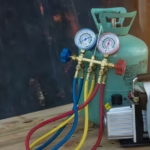REQUEST
CONSULTATION



As energy efficiency, building design flexibility, and indoor comfort become increasingly important to homeowners and businesses, ductless HVAC systems—also known as mini-split systems—are enjoying a surge in popularity. Once considered a niche solution, ductless systems are now emerging as a mainstream choice in both new construction and retrofit markets. With growing environmental concerns and the need for scalable solutions, the rise of ductless HVAC is more than just a trend—it’s a significant shift in how we think about indoor climate control.
This blog explores the reasons behind this rise, the technical and financial advantages of ductless systems, their applications across residential and commercial environments, and what stakeholders need to consider before making the switch.
Ductless HVAC systems, often referred to as mini-splits, consist of two main components:
These units are connected via refrigerant lines and require no ductwork. Each indoor unit operates independently and can be controlled individually, allowing for zoned temperature control across a property.
Some systems offer both heating and cooling capabilities, functioning as heat pumps. These systems are particularly popular in areas with mild to moderate climates but are increasingly being adopted in colder regions thanks to advances in heat pump technology.

Ductless systems are often significantly more energy-efficient than traditional forced-air systems. Because they eliminate duct losses—which can account for up to 30% of energy use in central air systems—they can deliver conditioned air more directly and efficiently.
Many ductless models are ENERGY STAR® certified and use inverter-driven compressors that adjust speed based on demand, further enhancing energy savings and comfort.
With ductless systems, each air handler can be programmed independently. This means you can:
This level of control is ideal for families with varying comfort preferences, multi-tenant dwellings, or buildings with mixed-use spaces.
Ductless systems require only a small hole for the conduit and don’t involve installing extensive ductwork. This makes them ideal for:
Installation is typically quicker and less disruptive than central HVAC systems, with many projects completed in a day or two.
Ductless systems often include multi-stage filtration that can reduce dust, bacteria, pollen, and other allergens. With no ducts to collect and distribute pollutants, they contribute to healthier indoor air.
Initial installation costs for ductless systems can be higher than traditional systems, particularly if multiple indoor units are required. However, this is often offset by:
With higher SEER (Seasonal Energy Efficiency Ratio) ratings and variable-speed compressors, ductless systems tend to have lower ongoing energy costs. Smart thermostats and programmable controls can further enhance savings.
Many local utilities and governments offer financial incentives for switching to high-efficiency ductless systems. For instance:
Ductless HVAC systems aren’t just for homes—they’re increasingly used in commercial settings like:
These settings benefit from the zoning capabilities and installation flexibility that ductless systems offer. In multi-tenant buildings, individual billing is easier with separate systems per unit.
Modern ductless systems are compatible with smart thermostats, remote control apps, and home automation platforms. Users can:
New ductless heat pumps can operate efficiently in temperatures as low as -15°F, making them viable for northern climates. Enhanced defrost cycles and variable-speed compressors maintain performance in extreme weather.
Ductless systems pair well with solar panels and battery storage systems, offering a path to net-zero energy homes and buildings. Their high efficiency means they can operate effectively on solar-generated electricity.
Despite their many benefits, ductless systems may not be ideal for every situation:
Still, the versatility of ductless technology allows it to be adapted to a wide range of building types and user needs.
A 1980s townhome with baseboard heaters switched to a ductless heat pump system with three indoor heads. The homeowner reported a 40% drop in heating bills and improved summer cooling comfort. The project qualified for a $1,200 utility rebate.
An aging HVAC system was replaced with ductless units in a multi-zone layout, allowing the dining area, kitchen, and storage rooms to be managed independently. Energy use dropped 25%, and comfort complaints from staff and customers were significantly reduced.

As building codes increasingly emphasize energy efficiency and as consumers demand more control over their indoor environments, ductless systems are expected to play a growing role. The global ductless HVAC market is projected to reach over $100 billion by 2030, driven by:
In residential, commercial, and even industrial applications, ductless systems offer a pathway to a more sustainable and comfortable future.
The rise of ductless HVAC systems reflects a broader evolution in how we think about comfort, efficiency, and sustainability. With benefits ranging from energy savings and air quality improvements to installation ease and technological flexibility, ductless systems offer a compelling alternative to traditional HVAC setups.
Whether you’re building a new home, upgrading an outdated system, or looking for a scalable solution for a commercial property, ductless technology deserves serious consideration. With the right planning and execution, it can deliver long-term value, performance, and peace of mind in a rapidly changing world.